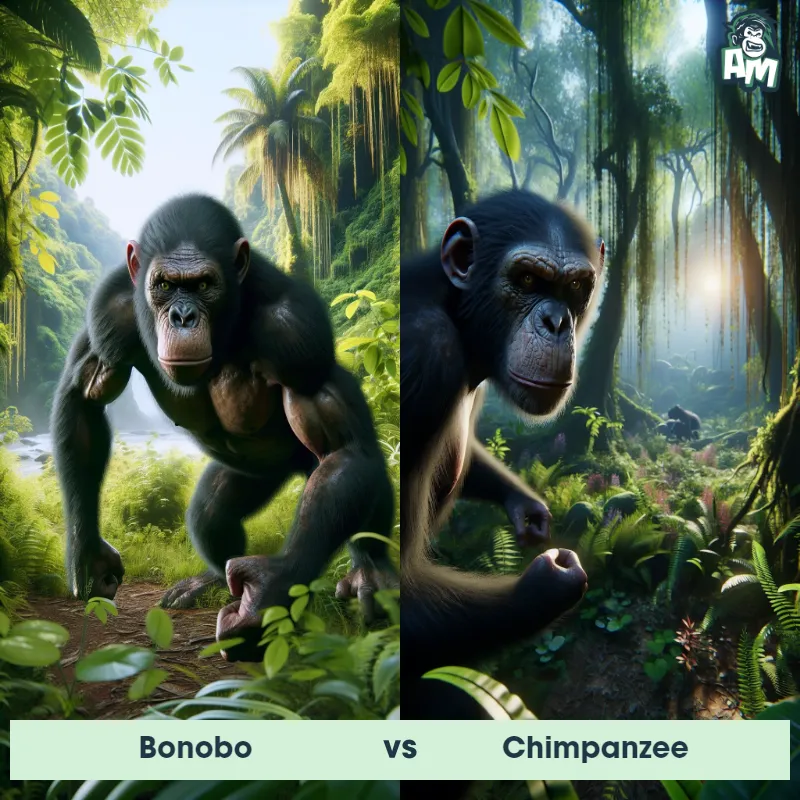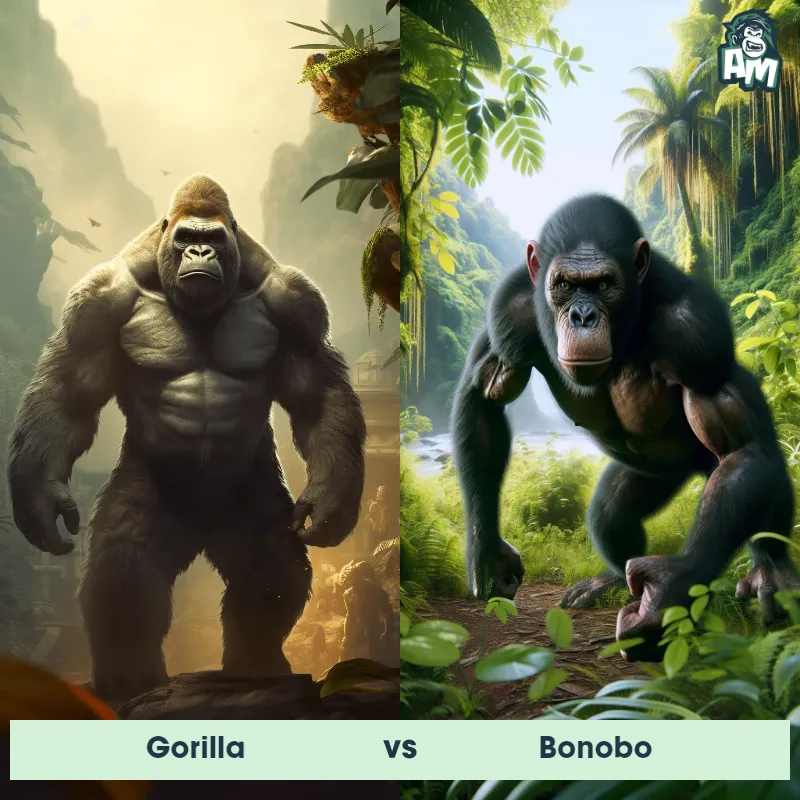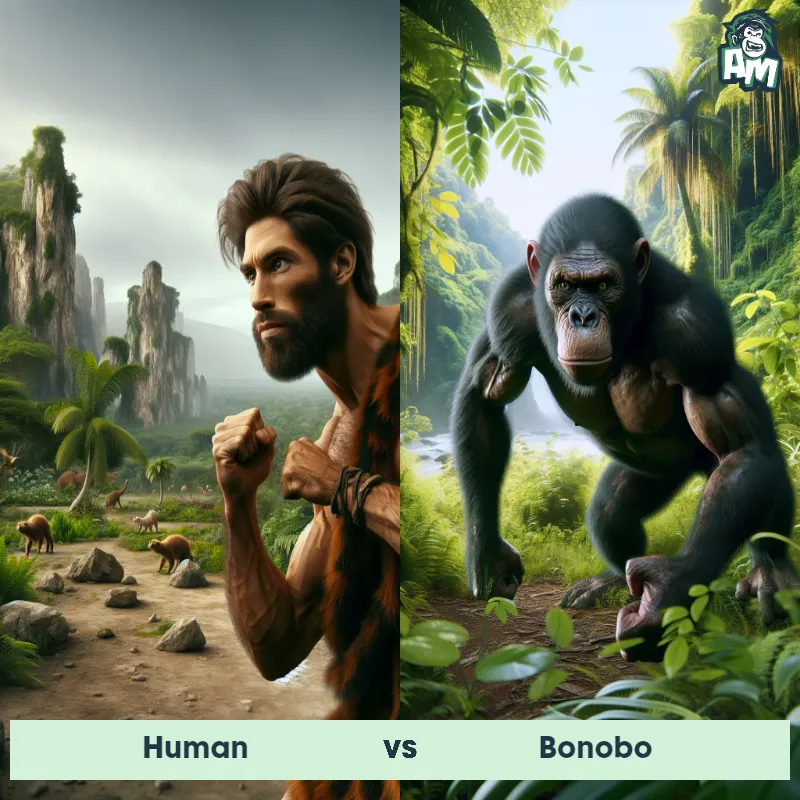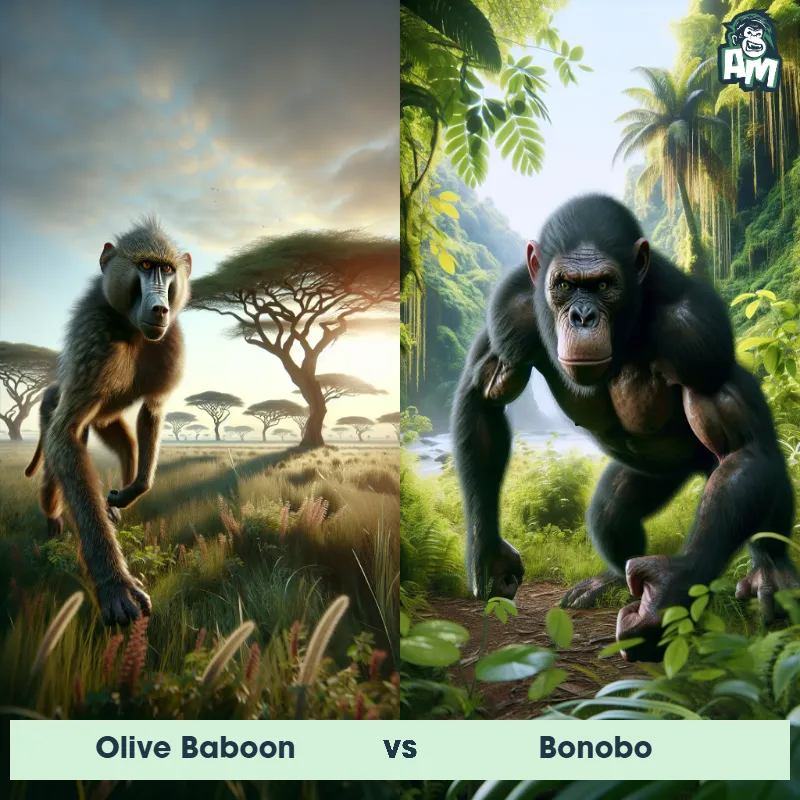The Bonobo
The Bonobo, scientifically known as Pan paniscus, is a highly intelligent and social great ape that resides in the dense rainforests of the Democratic Republic of Congo. They are closely related to humans and share over 98% of their DNA. Bonobos have a slim body with long limbs and a prominent forehead. Their black hair covers most of their body, except for the face, which has pink lips and a dark face mask. They possess opposable thumbs and have a gracile build, similar to chimpanzees but with a more slender frame.

| Bonobo | |
|---|---|
| Size | 3 to 4 ft (91 to 122 cm) |
| Weight | 66 to 86 lbs (30 to 39 kg) |
| Speed | 4 mph (6.4 km/h) |
| Key Strength | Agility and dexterity |
| Biggest Weakness | Lack of physical aggression |
| Scientific Name | Pan paniscus |
| Family | Hominidae |
| Habitat | Rainforests |
| Geography | Democratic Republic of Congo, Central Africa |
| Diet | Primarily frugivorous, also eats leaves, stems, and insects |
| Lifespan | 25 years - 40 years |

The Bonobo
The Bonobo, scientifically known as Pan paniscus, is a highly intelligent and social great ape that resides in the dense rainforests of the Democratic Republic of Congo. They are closely related to humans and share over 98% of their DNA. Bonobos have a slim body with long limbs and a prominent forehead. Their black hair covers most of their body, except for the face, which has pink lips and a dark face mask. They possess opposable thumbs and have a gracile build, similar to chimpanzees but with a more slender frame.
Fun Fact: Bonobos are renowned for their peaceful and egalitarian society, often resolving conflicts through sexual behaviors, such as genital rubbing, rather than aggression.
| Bonobo | |
|---|---|
| Size | 3 to 4 ft (91 to 122 cm) |
| Weight | 66 to 86 lbs (30 to 39 kg) |
| Speed | 4 mph (6.4 km/h) |
| Key Strength | Agility and dexterity |
| Biggest Weakness | Lack of physical aggression |
| Scientific Name | Pan paniscus |
| Family | Hominidae |
| Habitat | Rainforests |
| Geography | Democratic Republic of Congo, Central Africa |
| Diet | Primarily frugivorous, also eats leaves, stems, and insects |
| Lifespan | 25 years - 40 years |
Bonobo Matchups
We use AI to simulate matchups between the Bonobo and other animals. Our simulation considers size, strength, and natural predatory behaviors to determine the most likely outcome.

Can't find the Matchup you want?
Create Your Own MatchupBonobo: Diet, Predators, Aggression, and Defensive Behaviors
What do Bonobos eat?
Bonobos are primarily frugivores, meaning they eat mainly fruit. They also consume a variety of plant material such as leaves, flowers, stems, pith, bark, seeds, and mushrooms. In addition to plants, they occasionally eat small amounts of insects and even some small vertebrates like birds.
Do Bonobos have any predators?
In their natural habitat, Bonobos do not have many natural predators due to their large size and strong social bonds. However, they may occasionally fall prey to leopards and sometimes large birds of prey like eagles.
Are Bonobos aggressive?
Bonobos are known for their peaceful and non-aggressive nature compared to their close relatives, the chimpanzees. They have developed sophisticated methods to resolve conflicts, such as using sex as a way to diffuse tension and establish social bonds. Aggression in Bonobos is rare and usually occurs in the form of vocalizations, gestures, or minor physical displays.
Do Bonobos fight?
While Bonobos do engage in conflicts and disagreements, they are not known for engaging in physical fighting to the same extent as chimpanzees. Most disputes are resolved through peaceful means such as grooming, embracing, or using facial expressions. Physical fights among Bonobos are infrequent and usually involve minimal harm.
How do Bonobos defend themselves?
Bonobos have several strategies for defending themselves against potential threats or predators. They can vocalize loudly to alert other group members, climb trees to escape danger, and use their strong social bonds to coordinate group defense. In the face of a threat, Bonobos may also engage in displays of dominance or aggression to deter potential attackers.
What is Bonobos' biggest weakness in a fight?
Despite their overall peaceful nature, Bonobos' biggest weakness in a fight would likely be their lack of physical aggression and combat skills compared to some other primates. In a confrontational situation with a more aggressive species, Bonobos may struggle to defend themselves effectively through physical means and may rely more on social strategies to avoid conflict.
Fun Fact: Bonobos are highly skilled climbers and spend a significant portion of their time in the treetops, utilizing their long arms and dexterous hands to navigate through the dense forest canopy.
Fun Fact: Unlike most other primates, Bonobos walk upright on two legs bipedal locomotion at times, displaying a unique adaptation that allows them to cover short distances with greater efficiency, particularly in flooded habitats.














